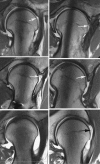No regeneration of the human acetabular labrum after excision to bone
- PMID: 25367108
- PMCID: PMC4353545
- DOI: 10.1007/s11999-014-4021-z
No regeneration of the human acetabular labrum after excision to bone
Abstract
Background: Treatment options for a symptomatic, torn, irreparable, or completely ossified acetabular labrum are limited to either excision and/or reconstruction with grafts. In a previous animal model, regeneration of the acetabular labrum after excision to the bony rim has been shown. In humans, less is known about the potential of regeneration of the labrum. Recent studies seem to confirm labral regrowth, but it is still unclear if wide excision might be a surgical option in cases where repair is not possible.
Questions/purposes: The purposes of this study were (1) to determine the extent of acetabular labrum regeneration after excision to the bony rim; and (2) to determine whether this procedure results in higher hip scores.
Methods: We reviewed all patients treated with surgical dislocation for symptomatic femoroacetabular impingement by a single surgeon at one institution between 2003 and 2008, of whom 14 underwent wide labral excision (of at least 60°) down to bone; we used this approach when there was an absence of reparable tissue. Of these 14, nine were available for voluntary reexamination. The mean age at surgery was 38 ± 9 SD years and the mean followup was 4 ± 1 SD years. All patients consented to a physical examination and an MRI arthrogram, which was evaluated for evidence of new tissue formation by four observers. A modified Harris hip score and the UCLA were recorded.
Results: Regrowth of a structure equivalent to normal labrum was not observed on the MRI arthrograms. Six of nine hips had segmental defects, bone formation was found in five, and the capsule was confluent with the new tissue in six. The mean Harris hip score at latest followup was 83 ± 14, and the mean UCLA score was 6 ± 2.
Conclusions: Resection of a nonreparable acetabular labrum down to a bleeding bony surface does not stimulate regrowth of tissue that appears to be capable of normal function by MR arthrography, and patients who underwent this procedure had lower hip scores at midterm than previously reported from the same institution for patients undergoing labral repair or sparse débridement. Based on these results, we believe that future studies should evaluate alternatives to reconstructing the labrum, perhaps using ligamentum teres, because resection seems neither to result in regrowth nor the restoration of consistently high hip scores.
Figures



Comment in
-
CORR Insights ®: No regeneration of the human acetabular labrum after excision to bone.Clin Orthop Relat Res. 2015 Apr;473(4):1358-60. doi: 10.1007/s11999-014-4070-3. Epub 2014 Nov 25. Clin Orthop Relat Res. 2015. PMID: 25421960 Free PMC article. No abstract available.
References
MeSH terms
LinkOut - more resources
Full Text Sources

